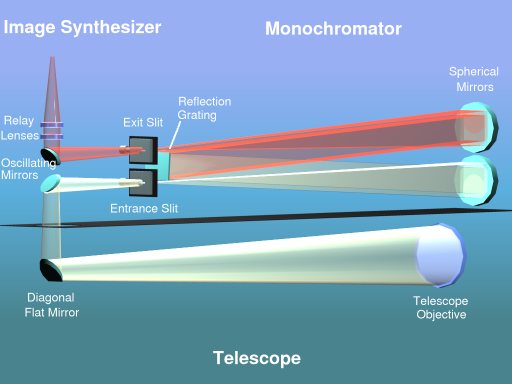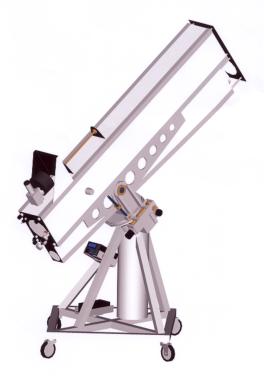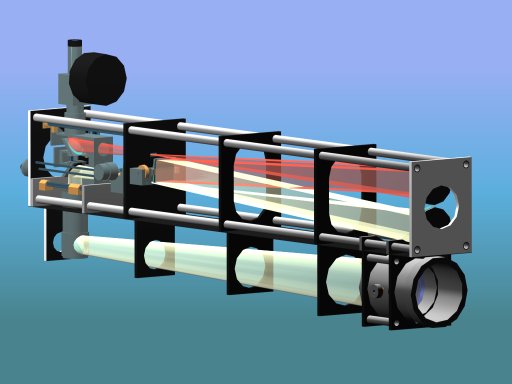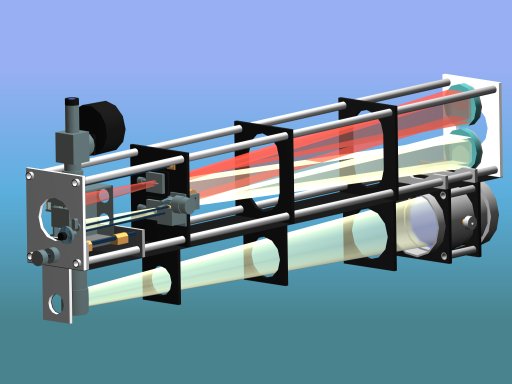
The spectrohelioscope is an instrument that can be used to study the sun in monochromatic light. In contrast to Ha filters a spectrohelioscope can be tuned to any wavelength in the visible spectrum. I am using it for both visual observation and CCD photography. You can find more information on spectrohelioscopes on the spectrohelioscope media archive.
The spectrohelioscope consists of three components: a telescope, a monochromator and an image synthesizer (see Fig. 1). The latter scans the (white light) image of the sun created by the telescope over the entrance slit of the monochromator. The monochromator passes only one color of light through its exit slit which the image synthesizer uses to construct the monochrome solar image. When the solar image is scanned 24 or more times per second the observer sees a complete image of the sun.

Figure 1: Spectrohelioscope optics.
The sunlight enters the instrument via the Fraunhofer achromatic lens of the telescope. This lens has a focal length of 1800 mm and a diameter of 150 mm. A flat diagonal mirror reflects the light to the image synthesizer.
The image synthesizer consists of two flat mirrors oscillating at 15 Hz which corresponds to 30 images per second. The first mirror (lower of the two) scans the white light solar image over the entrance slit of the monochromator. The second mirror constructs the monochromatic image of the sun from the light leaving the monochromator through the exit slit. When a CCD camera is attached to the spectrohelioscope, the scanning frequency of the mirrors is reduced to about 1 Hz or alternatively a single scan of the solar image could be performed per exposure.
The monochromator is of the Czerny-Turner type. It consists of a reflection grating, two slits and two spherical mirrors. The grating reflects the colors of the spectrum at different angles. By rotating the grating you can select the color of the light that leaves via the exit slit. The widths of the entrance and exit slits can be varied continuously from 0.008 up to 1.0 mm. The slits can be rotated to align them. The smallest bandwidth that can be obtained is a little under 0.1 Å which is close to the theoretical resolution that can be obtained with the grating. A reflector is mounted just in front of the entrance slit (not shown in the figure). This reflects most of the light that doesn't pass through the entrance slit back through telescope.
The relay lens system projects the solar image to a location that is readily accessible for visual observation using oculars and imaging with a CCD camera. The lenses reduce the size of the solar image to a little under 8 mm so that the solar image fits nicely on the chip of the CCD camera. It also enables me to use oculars I already own. With a flip mirror we can switch quickly from visual to photographic operation.
Our spectrohelioscope is mounted on a fork mount (see Fig. 2). Since the sun is always positioned between 24 degrees north and south of the celestial equator, the fork can be made shorter than for a telescope. The polar axis is driven by an electromotor at approximateley 30 rpm which is reduced by a factor of 44640 to approximately 1 revolution per day. Fine adjustment of the solar tracking speed is done by varying the voltage applied to the motor a little bit. Two shields, one placed in front of the spectrohelioscope and the other just in front of the CCD camera, are used to prevent heating by the light of the sun.

Figure 2: Spectrohelioscope on its fork mount.
Since the slits of the monochromator are rather narrow, the mechanical construction of the spectrohelioscope needs to be sufficiently stiff to prevent bending while it is tracking the sun. The internal construction of our spectrohelioscope is shown in Fig. 3 below. All optical parts except the telescope objective have fine adjustments.


Figure 3: Internal construction of the spectrohelioscope.
Telescope: Fraunhofer achromatic lens (from Sky Objectives), f=1800mm, D=150mm, diaphragm matching monochromator grating. Flat diagonal, 1.85 inch minor axis (Orion Telescopes and Binoculars). Solar image diameter about 16 mm.
Image synthesizer: two diagonal flats (from Orion Telescopes and Binoculars), 1.5 inch minor axis. Oscillating at 15 Hz or less about two parallel axes in antiphase. Maximum tilt angle 0.8 degree to both sides to scan the full solar image over the monochromator slits. Center of mirrors is 300 mm in front of monochromator slits. Oscillating mirrors are driven by a motor from a VCR.
Monochromator: Czerny-Turner configuration. Grating from Jobin-Yvon: 57x57 mm2, 1800/mm, blazed at 500 nm, 90% theoretical resolution. Two spherical mirrors from Edmund Optics: f=1143 mm, D=108mm. Slit widths can be adjusted from 0.008 to 1.0 mm. Minimum bandwidth about 0.1 Å.
Relay lens system: two achromats f=300 mm and f=150 mm, D=50 mm, and a planoconvex field lens f=400 mm, D=25 mm from Edmund Optics. Solar image diameter after relay lens system 8 mm.
Flip mirror system to switch between visual and photographic modes. One diagonal flat, 1.06 inch minor axis (Edmund Optics).
Cover plates and pipes are aluminium. Total weight 30 kg.
Equatorial fork mount driven by an 12 Volt electromotor at about 30 rpm. Reduction in gear of 36/15x60x310=44640 times to approximately the solar tracking speed. Fine adjustment by varying the voltage applied to the motor.